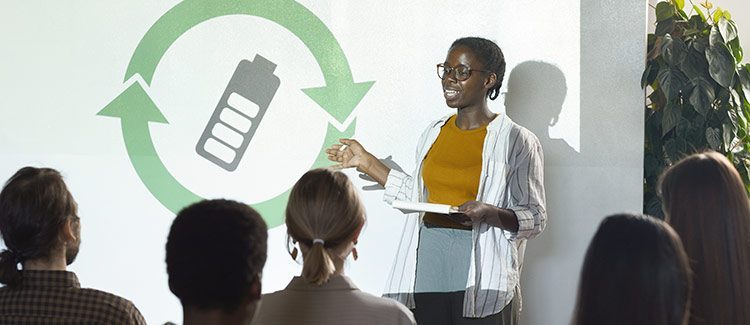The science fair has often been regarded as a staple of American education. For most students, and likely parents as well, the term immediately conjures images of trifold posters on display in the school gym.
But some high schools are taking the concept beyond science and robotics, using exhibitions to assess and celebrate students’ knowledge across disciplines. And while some of these presentations likely still incorporate those tried-and-true research posters, students are now using new forms of technology to show they’ve mastered essential skills.
Different kinds of exhibitions
At high schools that have doubled down on the value of student exhibitions, these public presentations can vary widely, not only in what they look like, but in their educational role.
At some schools, exhibitions are a way for students to simply make their learning relevant and tangible by celebrating their knowledge, skills, and experience with a larger audience. A high school might have all students share their multifaceted research papers with an informal exhibition night when parents are invited to peruse and speak to the young scholars about what they learned.
At others, exhibitions take the place of a final exam or even a high school exit exam. In these situations, they not only offer students the positive reinforcement of their learning by reaching a larger audience, they require students to show that they can apply their skills and knowledge to real-world problems and situations.
“In some ways, the performing arts have always done this,” says David Allen, professor and chairperson of the Department of Curriculum and Instruction at CUNY’s Staten Island College. “Students exhibit their skills on an instrument or voice or as an actor or as a dancer by giving a performance.”
How do exhibitions work when the subject is history or math as opposed to dance or violin? Typically students complete a project, such as a written paper, design, film, or any other ambitious task, working individually or collaboratively. Then they present that project publicly. The key element, Allen says, is that students use the presentation to demonstrate what they have learned not just to their peers and teachers, but to guests from outside of the school as well.
In a more formal exhibition, students might present to a panel of educators, experts, and community members who have reviewed the work ahead of time, or share their research during a public event attended by parents and neighbors. Though educators determine the final grade, students also receive feedback from outside visitors, which may be incorporated into the assessment.
Why student exhibitions work
Advocates for student exhibitions view them as a richer and more rigorous way for students to demonstrate what they’ve learned. That’s because students must literally show what they know and that they can apply it, according to Allen, which gives educators and parents a better sense of the progress students have made.
“When we assess students, it should be skills and knowledge that actually have meaning and application, and not just in school settings,” Allen explains. For instance, when a student presents her solution to a local environmental problem, she will likely draw on a wider array of skills and knowledge than if she simply wrote a paper for her teacher to grade. In sharing these ideas with the broader community, the learning not only becomes interactive and reaches a wider audience, it’s more relevant. Because projects can have an actual impact on the world, students see that learning matters.
It’s also a way to prioritize complex skills students will need for their future. Rather than selecting an answer from a series of options like they would on a multiple-choice test, students have to be able to write, discuss, and answer questions about what they’ve learned. This helps them build competencies they’ll need once they head to college or enter the workforce, Allen says, such as the ability to collaborate and use technology to communicate.
“It’s not enough to know how to solve a problem in math. You have to be able to explain how you’ve done it,” Allen says.
What student exhibitions look like when they’re done well
When used as a form of assessment, exhibitions should occur at a “culminating” moment, Allen says, such as the end of a unit, semester, or school year. At East Side Community High School in New York City, students share their work in roundtable presentations twice a year. They must complete projects in different disciplines and defend them before a formal panel in order to graduate.
East Side can assess its students this way because the school is a member of the New York City Performance Standards Consortium, which allows member schools to forgo the state’s standardized exam in favor of performance assessments.
At San Diego’s High Tech High in CA, a charter school featured in the documentary Most Likely to Succeed, an annual exhibition features student projects ranging from an exploration of homelessness in America to creative storytelling through dance and data visualization.
But exhibitions can also play a part at more traditional high schools, such as at Nipmuc Regional High School in Upton, MA.
In addition to a STEM symposium and fine arts show, the school also offers an interdisciplinary course called Legacy, in which students pursue a topic of their own choosing and then present the results of their research to their peers and the public. Guests at these symposiums, which can include subject-matter experts, parents, and other community members, provide feedback to the students that they can then use to improve their projects.
Senior Brynna Seligman chose to focus her most recent Legacy project on environmental issues. She created a simulation to demonstrate how ocean plastics become microplastics that impact the environment and explored environmental justice and policymaking through her involvement in the Youth Climate Strike Movement.
According to instructor Leigh-ann Miklavic, the projects are as varied as the students’ interests. One student recently created a magazine about the mental health effects of social media for the class, for example, while another pursued firefighting with an internship at a local station.
“All my projects have been about things I’m super passionate about, so it was a great experience getting to work on public speaking and sharing my knowledge and my hard work with the greater community,” Brynna says.
If they’re so great, why aren’t exhibitions more common in high school?
Like many educational innovations, exhibitions need to be implemented carefully to be equitable. “Students in the high-echelon independent schools and some of the elite public schools have always had the opportunity to exhibit their skills and knowledge,” Allen says. But at many public schools serving students from underserved communities, educators feel pressured to focus on standardized tests over other, richer ways for students to show what they know.
So how do you know if a school’s exhibition program is fair and equitable?
Exhibitions shouldn’t just be for advanced students. Exhibition opportunities should be open to all students, from those receiving special education services to those who have taken multiple advanced placement (AP) classes.
Exhibitions need not take the place of standardized assessments. Robust exhibitions of student work can be used alongside standardized testing, which can be a useful accountability tool to ensure all students are learning basic academic skills like reading and math.
Potential challenges or pitfalls
- Where’s the research? Although many education experts wax optimistic about the idea of robust exhibitions becoming a bigger part of American high school, there has been little research on exhibitions as an alternate form of assessment since the 1990s, when many researchers turned their focus to standardized testing.
- It’s not just a class presentation! Having a student present a book report to other students is not a true exhibition, for example, though some schools may call it that. “That means thinking about, how are you going to have students engage with others, besides the teacher, besides their classmates, to present their work?” Allen explains.
Key takeaways
For parents:
- As a parent looking at high schools, how do you know whether a school offers exhibitions as part of its educational experience? It may be easier than you think. Jen Field, an environmental science teacher at Nipmuc, notes that schools that are succeeding with exhibitions often share student work on their websites to showcase these programs.
- When looking for a high school for your child, try to see an exhibition in person. “That is one of the best sources of information parents can have, and also one of the best ways for them to understand how it really works,” Allen says, adding that other parents are often the best source of information about how well an approach is working — or not working — for their children.
For educators:
- If you’re interested in incorporating more exhibitions into your classroom or school, experts suggest taking a test-and-learn approach. It may take a few iterations to create an exhibition program that works for your students. “Start small and be willing to make mistakes,” Field says.
For administrators:
- If you want to use student exhibitions as a form of assessment, be prepared to take a look at all the learning goals and systems. “That form of assessment casts its shadow back on everything else that you do — what the students learn in their classes, how are the classrooms organized, what kinds of other assessments do students do so that they’re going to be prepared for this culminating exhibition of their skills and knowledge?” Allen says.
This article is part of our Transforming High School series, a collection of stories, videos, and podcasts exploring the practices that prepare students for success in college and beyond.






